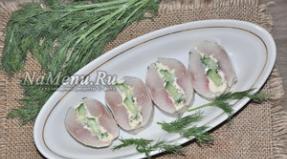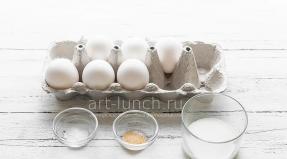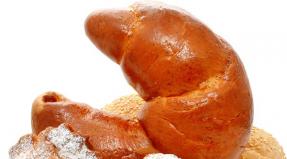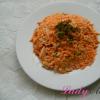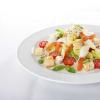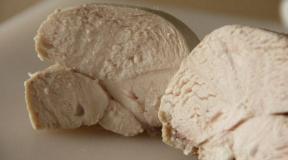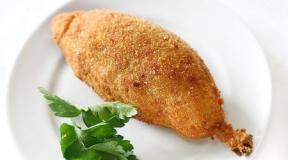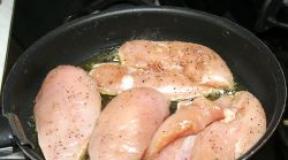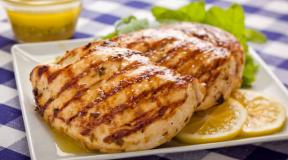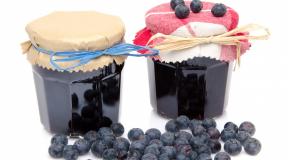What kind of barley is made from. Pearl barley is produced from barley
Article navigation:
The history of pearl barley
Pearl barley is one of the oldest grain crops, which was cultivated by man more than 10 thousand years ago. The name of the cereal - "barley" for porridge comes from the old Russian word "perly", which means - river pearls. Pearl barley received such a comparison due to the external similarity of polished barley grains with pearls.
About pearl barley
Pearl barley is made from the family of cereals - barley, from which the top layer (bran) is removed during processing, and then polished and polished. Most often, porridge is cooked from barley.
There are several varieties of pearl barley:
- ordinary barley- groats from whole barley, from which the shell has just been removed. As a result of minimal mechanical processing, it retains most of the lip fibers that are beneficial to the body.
- "Dutch"- a whole grain, rolled up to a ball, completely freed from the awn. It is quickly cooked, porridge from it turns out to be more delicate than barley.
- barley grits- in fact, this is an ordinary pearl barley, only crushed.
Choice of pearl barley
Choice of pearl barley should be based on its color. A quality product can be white, yellowish, even with a hint of green. The presence of any impurities in the packaging is excluded. If they are, the manufacturer does not monitor the quality of the cereal.
It is better to buy pearl barley in cardboard packaging.. In this it differs from most cereals, for which cellophane sealed bags are preferred. The fact is that during storage, the kernels give off the moisture contained in them. Condensation forms in cellophane, which is an ideal environment for the development of microorganisms. If you notice droplets of moisture inside the package, it is absolutely impossible to buy such a product, they can be poisoned. Plus, such cereals can have a rancid taste. Barley can be stored in a cardboard box for 6-12 months. When opening the package, the cereal should be smelled. The presence of a musty smell or its complete absence indicates that the product is old.
At home, barley should be stored in a ventilated container. It can be a jar with a loose lid or a cardboard box. Put it in a dark place.
The benefits of pearl barley
Pearl barley contains a large amount trace elements(iodine, nickel, zinc, bromine, calcium, strontium, cobalt, molybdenum, manganese, copper, iron and chromium) and necessary vitamins(B, PP, K, E, D, A), and is also rich in fiber, which contributes to the normal functioning of the intestines.
The main useful qualities of barley cereals:
- pearl barley contains lysine. It is an amino acid involved in the production of hormones, antibodies and digestive enzymes. In foods, lysine is not common, but getting it from food is extremely important, since the amino acid is indispensable, that is, it is not produced in our body. Red meat and soy are good sources. But in the greatest volume it is contained in cheap pearl barley.
- a lot in pearl barley. Another valuable trace element, the presence of which in the diet depends on the intensity of calcium absorption. Moreover, there is a lot of phosphorus in cereals - up to 350 mg per 100 grams of the product. The record holder is cereals and in terms of content potassium necessary for the health of the heart, blood vessels.
- barley contains B vitamins. They are required for normal operation. nervous system. For this reason, the use of cereals is recommended for people experiencing significant nervous stress. And the regular use of barley in food has an anti-stress effect.
- barley contains 77% carbohydrates. However, the calorie content of barley porridge is low. This is due to the fact that its carbohydrates are absorbed for a long time, for several hours. A long feeling of satiety and a low glycemic index become the basis for the use of the product in a healthy diet. Groats are recommended for people who are overweight due to their satiety, patients with diabetes mellitus, since when they enter the body it does not cause a “spike” in blood sugar.
- pearl barley contains more fiber than even wheat, due to which it removes intestinal toxins from the body, adsorbs toxins, formed during the life of the conditionally pathogenic intestinal microflora. Barley can even cure allergies. Barley grain contains a natural antibacterial agent - hordecin, this substance is actively used for flexible infections of the skin.
Harm of pearl barley
Barley is contraindicated in celiac disease (gluten enteropathy). With this disease, an allergy to barley protein (and some other cereals) - gluten (gliadin) is manifested. In this disease, consumption gluten cereals (wheat, rye, barley, oats) leads to the death of the intestinal villi and malabsorption of nutrients.
Barley porridge should not be included in the diet of children under 1 year old. It can cause indigestion, and if there is a tendency to celiac disease (it is genetically formed), it can cause slow absorption of nutrients in the intestines.
Preparation of pearl barley
In order for barley porridge to show maximum useful properties and please with a rich taste, it must be cooked and consumed correctly.
- kernels must be soaked in water. The holding time is 12 hours, during this period the grains will swell and cook faster. If you boil them without soaking, the protein contained in them will curdle, and the barley will become tough.
- The best cooking method is in a water bath. According to this recipe, porridge was cooked in Russia. Soaked kernels should be poured with milk (2 liters per glass of dry grain), boiled and put in a water bath to languish for 6 hours.
- normal cooking time for barley- 50 minutes. Some varieties are boiled for an hour and a half, and pre-steamed barley from bags - about 45 minutes
- 2 cups of water are taken per glass of cereal, if necessary, the liquid is added. The foam must be removed manually with a spoon or slotted spoon, and the cereal itself must be washed before cooking. Ready cooked barley can be used as a basis for pilaf, or as an independent side dish.
Pearl barley recipes

Ingredients:
- 1 glass of pearl barley
- 1 each - carrots, onions, bell peppers
- 1 tablespoon unrefined sunflower oil
- 400 g chicken horns
Cooking method:
Cut the breast into strips, steam the grits in a double boiler for 20 minutes or soak overnight. Cut the vegetables as you like, pour the oil into the multicooker bowl, lower the vegetables and fry, stirring occasionally. Add cereal, chicken, and pour 1 glass of chicken broth and 1 glass of water or just water. Cook for about 1.5 hours, in stewing mode.

Ingredients:
- 1 glass of barley
- 500 g fresh mushrooms
- 1 white onion
- silent celery, dill, parsnip, zira, turmeric
- salt to taste
- 1 tablespoon olive oil
- 2.5 cups bouillon or celery root broth
Cooking method:
Put the multicooker in the frying mode and quickly fry on both sides, stirring, pre-chopped vegetables and gibs. Add a glass of pearl barley, broth and cook in stewing mode for about 1.5 hours.

Ingredients:
- 2.5 cups skimmed or almond milk
- 1 cup pre-cooked pearl barley
- cinnamon
- sugar and salt to taste
Cooking method:
Put the steamed groats into the bowl of the multicooker and pour over the milk. Cook strictly in simmer mode, 50 minutes or longer. Usually milk porridge is made “shorter”, for this the pre-steaming period is increased to 40 minutes.
A decoction of pearl barley
A decoction of pearl barley is used in the presence of inflammatory processes in the stomach, it is especially recommended in the postoperative period after a surgical operation in the abdominal cavity. The decoction can be prepared both in water and in milk.
Decoction recipe:
- Pour 250 g of pearl barley into 1.5 liters of hot liquid (water, milk), you can add a little salt or sugar to taste. Bring to a boil and cook for about 20 minutes. The resulting broth does not need to be filtered, it will be the consistency of liquid sour cream.
- Take 100-200 g at a time, 3 times a day.
- Store no more than a day.
You can even use the water in which pearl barley was soaked, because. it contains hordecin. This substance has antibiotic properties. Water can be used in the complex treatment of fungal skin diseases.
The chemical composition of pearl barley
Nutritional value in 100 gamma pearl barley:
Calories:
- Proteins - 9.91 g
- Fats - 1.16 g
- Carbohydrates - 77.72 g
- Dietary fiber - 15.6 g
- Ash - 1.11 g
- Water - 10.09 g
Energy value in 100 gamma pearl barley: 352 kcal
vitamins
- Beta-carotene - 0.013 mg
- Vitamin A (RE) - 1 mcg
- Vitamin B1 (thiamine) - 0.191 mg
- Vitamin B2 (riboflavin) - 0.114 mg
- Vitamin B5 (pantothenic) - 0.282 mg
- Vitamin B6 (pyridoxine) - 0.26 mg
- Vitamin B9 (folic) 23 mcg
- Vitamin E (TE) - 0.02 mg
- Vitamin K (phylloquinone) - 2.2 mcg
- Vitamin PP (Niacin Equivalent) 4.604 mg
- Choline - 37.8 mg
Macronutrients
- Calcium - 29 mg
- Magnesium - 79 mg
- Sodium - 9 mg
- Potassium - 280 mg
- Phosphorus- 221 mg
trace elements
- Iron - 2.5 mg
- Zinc - 2.13 mg
- Copper - 420 mcg
- Manganese - 1.322 mg
- Selenium - 37.7 mcg
No wonder barley, from which pearl barley is actually made, was one of the main ingredients in the kitchen of our grandmothers. This porridge is one of the healthiest and has properties that strengthen the body. We often forget about this useful product, replacing it with others. Meanwhile, barley is one of the most ancient cereals grown by man. It is believed that almost 10 thousand years ago this culture grew on different continents. And it was especially appreciated where the cultivation of other, more demanding grains was impossible.
What is pearl barley
Pearl barley is a product made from barley by cleaning the grain bran, which is then ground and polished. The name of this porridge comes from the old Slavic word "perla", that is, pearls. Barley grains are oval and white (or with a yellowish tinge).
Barley is considered to be one of the very first "domesticated" crops and remains one of the main cereals to this day. Ancient civilizations used this plant as food for themselves and animals. It is mentioned in the Bible as one of the seven products intended for sacrifices, and the ancient Babylonians made wine from barley as early as 2800 BC. In addition, ancient barley was used for many medicinal purposes. In the Middle Ages, this crop gained its popularity due to the high cost of wheat. Many Europeans in those days baked bread from a mixture of rye and barley flour, and wheat pastries appeared on the table only on special occasions.
This plant adapts well to any environmental conditions. We can say that barley grows even where nothing grows. By the way, the progenitor of modern barley still “lives” in Israel, Egypt, India, Pakistan, and China. For industrial purposes, this cereal is grown in the Russian Federation, Germany, Spain, France, Canada and the USA.
The nutritional value
Pearl barley is the leader in content, it is rich in vitamins and. This cereal contains, which have a beneficial effect on the nervous system. It contains (necessary for better absorption of calcium and phosphorus by the body), vitamins A and E, which are responsible for the beauty of nails, hair, skin, as well as vitamin K, necessary for the normalization of blood clotting.
Among the trace elements contained in barley porridge, there are especially large reserves of iron, calcium and potassium. In addition, barley contains selenium, copper, zinc, manganese, and other useful components.
As for proteins, the proteins contained in barley are much richer than wheat. Barley contains a lot, which is involved in the synthesis of collagen (necessary to maintain skin elasticity, protect against the appearance of early wrinkles).
| calories | 123 kcal |
| 2.4 g | |
| 0.5 g | |
| 28.2 g | |
| 7 IU | |
| 0.81 mcg | |
| 0.12 mg | |
| 0.13 mg | |
| 2.12 mg | |
| 0.15 mg | |
| 0.13 mg | |
| 16.2 mcg | |
| 13.4 mg | |
| 11.2 mg | |
| 1.31 mg | |
| 22.2 mg | |
| 54 mg | |
| 93 mg | |
| 3.2 mg | |
| 0.81 mg | |
| 0.11 mg | |
| 0.33 mg | |
| 8.6 mcg |
Benefits for the body
 Pearl barley belongs to cereals that do not contain gluten and do not have any serious contraindications for consumption. It is believed that pearl barley is especially useful for pregnant and lactating mothers, as well as for people:
Pearl barley belongs to cereals that do not contain gluten and do not have any serious contraindications for consumption. It is believed that pearl barley is especially useful for pregnant and lactating mothers, as well as for people:
- with high, coronary heart disease, atherosclerosis;
- with inflammatory and other bowel diseases;
- with a weakened immune system.
This porridge is also recommended as a product that prevents the growth of malignant tumors, diseases of the genitourinary and nervous systems, and prevents anemia and gallbladder diseases. Interestingly, barley groats improve lactation and also have antiviral properties.
Rich source of fiber
Barley is one of the best sources of fiber among cereals. But the main feature is that the dietary fiber in this porridge is presented in a fraction called beta-glucan. It is a water-soluble fiber that, when ingested, absorbs moisture and provides a feeling of satiety. But even this is not the main advantage of beta-glucans. Studies have shown that these substances can significantly lower cholesterol levels. According to the results of the experiment, in people whose daily diet contains at least 3 g of beta-glucans, cholesterol levels are 19-24% lower than in people who do not consume barley.
By the way, beta-glucan can often be seen in the list of ingredients of different foods. Meanwhile, experiments have shown that the “chemical” glucan is not as effective as the natural substance in pearl barley. Interestingly, 100 g of cereal contains approximately 4.3-5.3 mg of beta-glucan.
In addition, the special fiber contained in pearl barley improves metabolism, thereby preventing a sharp increase in blood glucose concentration. For this reason, barley is considered a porridge useful for diabetics.
Useful properties for the digestive tract
The special chemical composition of barley makes it beneficial for the intestines. Barley contributes to the restoration of healthy microflora, on which, as you know, the general well-being of a person and his immunity depend. In addition, barley porridge and a decoction of it have enveloping abilities, which makes these products useful for people with ulcers and gastritis.
healthy bones
Iron, phosphorus, calcium, manganese, magnesium, zinc are the minerals that are necessary to maintain bone strength and proper bone structure. And all of them are contained in sufficient quantities in pearl barley. A balance of phosphate and calcium is essential for proper bone mineralization. The consumption of excessive amounts of phosphorus and a lack of calcium leads to bone loss. But you don’t have to worry about this if there is room for barley in the diet. In addition, manganese, as well as iron and zinc, are necessary for the formation of collagen in the body, which is important for maintaining joint health.
strong heart
Fiber, potassium, vitamins B6 and B9, which are part of pearl barley, are important components for maintaining heart health.
Barley, as already noted, is an excellent source of fiber, which helps lower cholesterol, which in turn is important in preventing heart problems. On the other hand, a daily intake of 4 mg of potassium has been shown to reduce the risk of death from coronary heart disease by 49%. And vitamin B6 and folic acid, which are present in barley, prevent the accumulation of a substance known as homocysteine. Its excessive amount leads to problems with blood vessels and heart muscle.
 Porridge against cancer
Porridge against cancer
Among the useful components that make up barley, there is selenium. This substance plays an important role for the liver - it helps to cleanse the tissues of this organ from carcinogenic compounds. In addition, selenium prevents inflammation, reduces the growth of malignant tumors, improves immunity and stimulates the production of so-called T-substances in the body, which resist cancer cells.
Protection against gallstones
By eating a diet rich in dietary fiber (and barley is one of them), you can avoid the formation of gallstones. So says a group of American scientists who conducted a study for 16 years with the participation of about 70 thousand women. Researchers have calculated that with regular consumption of insoluble fiber, the risk of gallstones is reduced by 13-17%. Scientists believe that insoluble fiber from pearl barley helps move food through the intestines and reduces the secretion of bile acids, which, in fact, provoke the formation of stones.
For skin treatment
But as it turned out, not only pearl barley, but also the water in which porridge was boiled or soaked brings benefits to humans. In this liquid, scientists found antibacterial substances, in particular gordecin. This substance is useful for the treatment of fungal skin diseases.
The liquid in which porridge was cooked has been used by our ancestors since ancient times as a remedy. In folk medicine, this decoction was famous as a remedy that:
- improves lactation;
- heals the liver;
- promotes weight loss;
- strengthens the body;
- treats diseases of the mammary glands;
- relieves coughs and colds.
In addition, today they say that this decoction helps prevent the growth of oncological formations.
Side effects
Barley is a cereal that contains gluten. For this reason, barley porridge should be avoided by people with celiac disease. It is also important to remember that pearl barley is an extremely high fiber product. And this means that it is important for lovers of this porridge to take care of sufficient water intake. Otherwise, constipation cannot be avoided. In addition, there is an opinion that excessive passion for this porridge reduces libido in men.
Use in cooking
 After heat treatment, barley grain acquires a nutty flavor, which makes it a product that goes well with savory sauces, herbs, vegetables and even fruits. By the way, pearl barley can be replaced without spoiling the taste of the dish.
After heat treatment, barley grain acquires a nutty flavor, which makes it a product that goes well with savory sauces, herbs, vegetables and even fruits. By the way, pearl barley can be replaced without spoiling the taste of the dish.
To get the perfect consistency of porridge, barley is recommended to be cooked in the proportion of 3 parts of water and 2 parts of porridge. Mix the ingredients in a saucepan, add a little oil and bring to a boil. After a little reduce the heat, stir and cook under a closed lid for about 20 minutes (stir from time to time so that the porridge does not burn). Salt when barley is already soft and almost ready.
Barley is a cereal loved by many culinary specialists, since porridge from it is universal. It has a unique taste that allows you to combine it with both salty and sweet dishes.
Barley porridge is in harmony with meat and vegetarian dishes. It is used for making desserts, milk soups, casseroles. Minced meat for cabbage rolls, pancakes are prepared from it, and they are also added to minced meat.
Application in cosmetology
 And pearl barley is a porridge of beauty. This is what women in many countries call this cereal. And they have every reason to do so. Being a rich source of many vitamins, this product is extremely beneficial for skin, hair and nails. The easiest way to use is to eat. But masks, scrubs and tonics can also be made from this porridge. Pearl masks restore the skin to its former elasticity. Especially useful masks from this miracle porridge for the skin of the eyelids.
And pearl barley is a porridge of beauty. This is what women in many countries call this cereal. And they have every reason to do so. Being a rich source of many vitamins, this product is extremely beneficial for skin, hair and nails. The easiest way to use is to eat. But masks, scrubs and tonics can also be made from this porridge. Pearl masks restore the skin to its former elasticity. Especially useful masks from this miracle porridge for the skin of the eyelids.
Mask for the face
Add milk to pearl barley and boil (until porridge is formed, resembling a thick consistency). Spread the mixture evenly over the skin of the face and décolleté while still warm. Keep at least half an hour. Wash off with warm water. Repeat this procedure at least 2 times a week for a month. The result is toned, fresh skin without wrinkles.
pearl tonic
Pour a tablespoon of ground pearl barley with a glass of boiling water and boil (cook for about 20 minutes over low heat). Cool the finished broth, strain, add a little vegetable oil and a few drops of lavender in the form of essential oil to the liquid. Use to cleanse and nourish the skin. This remedy is good for preventing early aging of the skin of the face.
Barley is an amazing cereal with a versatile taste. When the weather is cold and humid outside, a large pot of fragrant pearl barley and meat will warm, saturate and replenish the reserves of essential minerals, proteins and vitamins.
In the old days, pearl barley was considered a delicacy and was valued for its beneficial properties, so it even got the name of pearl groats. After a while, the product became familiar and generally available, and at the same time lost its former popularity and became one of the main products of the diet of soldiers in military units, which was later replaced by buckwheat. Despite all this, we recommend that you take a closer look at pearl barley, because it contains a large number of various useful substances.
What grain is cereal made from?
Pearl barley or simply pearl barley is presented in stores in a large assortment. At the same time, everyone understands what buckwheat or rice is made of, and what cereal is this product made from? Barley is obtained from barley grains, which are polished with a partial removal of the upper layer, and the grains acquire an oblong shape.
Another processing technique is also used, in which the entire shell is removed from the grains, and the grain turns out to be round. Such cereals are called Dutch and in terms of grain size it is smaller than ordinary barley. By carefully grinding cereals, manufacturers create barley groats, which many do not associate with barley at all, although in fact it is one product.
Previously, pearl barley was expensive due to the complexity and laboriousness of the grain processing process, so it was eaten exclusively by wealthy people. Gradually, it became more and more accessible and turned into a public product, which contains numerous vitamins and minerals.
Calorie content and nutritional value of the product
Most of the beneficial properties are preserved with incomplete grinding of barley grains, therefore it is precisely this barley that people who monitor their health add to their diets. Barley contains many useful components, namely:
- proteins;
- healthy fats;
- cellulose;
- vitamins A, B, D, E, PP and some others;
- iron, selenium, zinc and several other trace elements;
- macronutrients, among which the most valuable are calcium, magnesium, potassium and phosphorus;
- amino acids.
The number of calories in pearl barley is 275 kcal per 100 grams, and it also has a good BJU ratio:
- proteins 7.5 g;
- fat 1.5 g;
- carbohydrates 58 g.
Thanks to this, pearl barley dishes are very nutritious and useful for people involved in sports and dieting.
What is useful barley?
The most important advantage of barley is the high content of fiber, which is valuable for the body. It affects the digestive system like a broom, which cleans out harmful deposits and helps with constipation. This product is also a good antioxidant that fights free radicals.
Due to the high content of vitamins and phosphorus, barley promotes the absorption of calcium and normalizes the functions of the nervous system. Moreover, the product contains many other trace elements that strengthen the immune system and normalize work. internal organs. Barley, depending on the method of preparation, can be a dietary product for weight loss, and it is also indicated for diabetics with strict therapeutic diets.
The pearl barley dish contains hordecin, which is a natural antibacterial agent that fights bacteria and fungi. There are a large number of amino acids in cereals, among which there are irreplaceable ones, therefore athletes like to prepare nutritious meals from this cereal.
One of the amino acids is lysine, which is important for immunity, collagen synthesis and maintaining the functions of the eye lenses. The silicic acid present in the cereal is useful in diseases of the urinary and gall bladders, as well as kidneys. The substance destroys stones and sand, facilitating their removal from the body.
Is it possible to harm barley?
With many useful properties barley has a number of contraindications and can harm under certain circumstances. In this regard, barley on the water or in any other form should be eaten in moderation and not every day. The harm of cereals is as follows:
- the high fiber content makes the cereal unsuitable for people with stomach and duodenal ulcers, as well as exacerbations of gastritis;
- frequent constipation and bloating also force people to refuse barley;
- it is not recommended to take calcium preparations immediately after barley or vice versa (an interval of at least 2-3 hours is needed);
- barley can be included in the children's diet from 2-3 years old, as it is difficult to digest;
- men should not abuse this cereal because of the risk of reducing potency.
If you use the product in moderation, even with a problematic gastrointestinal tract, it will not harm, so just follow the measure.
Why is barley useful for women?
Thanks to lysine, which promotes collagen synthesis, pearl barley prevents the appearance of mimic wrinkles in women and preserves the freshness of the skin. It is recommended to consume cereals 1-2 times a week. Antioxidants and vitamins from the composition also have a positive effect on the functioning of the female body, regulating age-related changes and normalizing the condition of the hair.
Scientific studies confirm the benefits of water porridge during or before menopause, and the dish also reduces the risk of osteoporosis and breast cancer. All this is due to the content of the antioxidant selenium, which suppresses free radicals. During the period of breastfeeding, it is useful for women to cook barley by maintaining lactation and supplying the body of a young mother with valuable nutrients.
Benefits for men
Barley is also very useful for the representatives of the stronger sex, as it is an energy product with vegetable protein. Groats are included in their diets by athletes, military personnel and people who tolerate high physical exercise.
Inexpensive barley, made from barley grains, saturates the male body with valuable proteins and fiber, increasing endurance and promoting muscle building. You can add butter, milk, dried fruits, nuts or cream to barley for taste. All this will increase the nutritional value of the product, which is important for some athletes.
How and how much to cook pearl barley
Groats can be cooked in many ways, and how much it needs to be cooked depends on the type of grains. Coarse and hard requires two hours of cooking, but if you pre-soak it in cold water overnight, the cooking time will be reduced, and the dish will get a more pleasant taste.
How many minutes to cook this or that barley, you can find out on the package. With pre-soaking, the cooking time varies from 30-40 minutes to one and a half hours, depending on the variety and size of the grains.
Cooking methods
The benefits and harms of pearl barley are multifaceted, so you should definitely learn how to cook it. There are quite a few ways, but consider the two most popular:
- Soak the cereal overnight in cold water or pour boiling water for an hour and boil for 10-15 minutes, then drain and rinse the cereal. For three glasses of water, you need 250 g of barley: the grits are poured with water, brought to a boil and boiled for 50-60 minutes over low heat. After that, the cereal is left to brew for at least half an hour.
- After soaking, barley is placed in a saucepan with thick walls, poured with water (3 cups per 250 g of cereal) and left for an hour in the oven. After turning off the oven, the porridge is left to reach for 30-40 minutes.
Cooked in the chosen way, you can season with butter or vegetable oil to make it more crumbly. Then the resulting dish will be not only healthy, but also tasty.
Barley contains a lot of useful substances, but is it possible to use this product for children, sick people and women during pregnancy? It is important to be aware of the harm and benefits of pearl barley for the body.
The inclusion of barley dishes in the diet is necessary to normalize digestion and heart function. The state of the body improves due to the intake of a sufficient amount of trace elements and vitamins.
Washing and Rinsing Many grains that we buy whole and raw or dry need a good rinse, especially quinoa because it is coated with a resin that gives a very bitter and unpleasant taste. Some whole rice also needs to be pre-cooked, as do sorghum and millet to remove grain or pebbles. If you bought cereal in the form of flakes, flour, semolina, germ or bran, do not wash it, you would ruin it.
Soaking Some grains are quite hard and take a long time to cook, so it's best to leave them to soak for hours before cooking them, as is the case with many vegetables. All of this, of course, is for whole grains, not for pre-cooking. Rinse the rust first, and then let it soak for 4 to 8 hours. You can use this water for cooking. Some rices are also very heavy, as are some types of black rice, and will need to be left to freeze between 2 and 4 hours before being used.
Consider the beneficial properties and possible contraindications when using pearl barley.
Useful properties of cereals
- Cleansing. Due to the content of fiber, which improves intestinal motility, accumulated toxins and deposits are removed from the body. It is recommended to use pearl barley for people who have problems with the bladder or gall bladder, kidneys, since it contains silicic acid, which removes stones, sand, and slags.
- Anti-inflammatory . A decoction of cereals eliminates the inflammatory processes occurring in the stomach, it is useful after operations on the digestive tract. When cooked, a starch-protein mucus is formed, which has enveloping properties. It is recommended to use porridge for stomach ulcers, especially during an exacerbation of the disease, in order to alleviate the condition.
- Restorative . Vitamin A, contained in pearl barley, improves immunity, improves visual function, the condition of the mucous membranes. In addition, it prevents the penetration of bacteria through the respiratory tract, helps fight colds.
- restorative . Pearl barley contains a sufficient amount of lysine, which helps the heart to function. The amino acid restores tissues, participates in the processes of their renewal and growth, the production of collagen.
- Antibacterial . The composition includes hordecin - a natural antibiotic. With regular intake of porridge, metabolism is improved, blood is cleansed, brain activity increases and cholesterol in the blood decreases. It is worth mentioning the expectorant qualities. Barley porridge components normalize the processes occurring in the body.
Harm and contraindications
Even healthy products are harmful to health if used improperly. To get the maximum benefit, barley should be consumed hot.
Cereals are the seeds of herbaceous plants such as wheat, rice or barley. They include the plant's embryo, which in turn contains a beautiful and durable box of nutrients for her growth. Quinoa and amaranth, among others, are considered pseudo-translations because they are not herbs but have almost the same nutritional properties and uses.
These true survivors of the plant kingdom thrive in both sun and low temperatures or poor soils. In prehistory, cereals were the first to be saved and because of this it was important for a nomadic society to form its roots, today it is a staple food for half of the world's population.
Harm
With abuse, gas formation increases, so the product is excluded from the diet with high acidity of the stomach, frequent constipation. In some men, due to excessive use of pearl barley, potency is impaired, libido is reduced.
The plant is very resilient and superior in nutrients to other cereals. It contains 9 essential amino acids and is therefore considered a source of protein. It is gluten free and easy and quick to prepare. Your cooking: wash, moisten, remove water and boil. Calculate 1 part of the quinoa for 2 water.
Amaranth: Sacred food of the Aztecs, pseudo-targeted and realistic with spinach and spinach. Rich source of protein and calcium, gluten free. Their preparations are varied from soups to pastries. Its grain is small and confused with the seeds, creamy, mixed with other baking flour.
Hazardous Properties
Pregnant women should be wary of pearl barley dishes, as it provokes gas formation and contains gluten. Before use, you should consult a doctor, because gluten is a complex protein that can lead to digestive disorders, constipation.
Buckwheat or Buckwheat: Belongs to the rhubarb family and sorrel can be found raw or roasted. It is also rich in protein and other nutrients. Its raw grain is somewhat bulbous, triangular. The roasted grain is reddish brown, its flour is gluten free and has many uses.
Japanese Owl Noodles: Fine brown, rough texture sometimes made with a mixture of wheat and buckwheat, so if you're only looking for buckwheat, read the nutrition label well. Preparation: wash, soak, remove water from the soak and boil 1 part of buckwheat for one and a half to two times.
People who are prone to allergies need to make sure that the body's normal reaction to the amino acids that barley is rich in.
Healthy people can use pearl barley every week, but no more than three times. Otherwise, there may be problems associated with the leaching of calcium from the body - brittle bones in adults, rickets in children.
What grain is pearl barley made from?
Rich in protein and fiber, more than regular wheat. It is served with or in risotto, soups, stews and salads. It is a large grain, reddish brown, also found in flour and pearls. Barley: very versatile in the kitchen, not only serving in soups but also elegant in salads and risottos. It consists of whole grains, pearls and flour, low in gluten.
Barley porridge with pork
Its preparation: washing, soaking, removing soaking water and cooking - 1 part barley to 2 and a half water. Millet: the main support of West Africa and East Asia. It is one of the most delicious cereals that exist, and its preparations are very diverse. It is a small pale yellow grain and its gluten free flour is served with other flour mixes.
Barley is made from barley. As a result of grinding barley grains, several types of grits are obtained, which corresponds to a certain degree of processing.
Types and varieties of barley groats
Kinds
Depending on the characteristics, barley groats are divided into three types:
- pearl barley obtained as a result of primary processing;
- dutch- grains in the form of balls, which are obtained after careful processing;
- barley grits - grains subject to grinding.
Pearl barley is harsh in its structure. Dutch dishes are less rigid, cooking takes less time. Porridge from barley groats is cooked very quickly, it turns out viscous.
Preparation: rinse, soak, soak in water and boil. Boil water in a saucepan, put the millet for 10 minutes, and then squeeze it out. Oats: The cradle of this hardy cereal that thrives in extreme conditions is Scotland, but Ireland is also credited with its origin. Theoretically, this cereal is gluten-free and is contaminated in its packaging and processing by the other cereals they contain. We find it in muesli, cookies, stews, desserts, flour, etc. an excellent source of fiber and other nutrients.
It comes from a light yellow color, must be soaked and cooked, also in split grain and flake format, whole grains are partially steamed and ground to reduce cooking time, as well as instant and fortified. Brown Rice: By keeping the bran and germ intact, brown rice concentrates many more nutrients than white rice. It improves the glycemic index and is gluten free. We find the integral short and long grain, the base integral and red.
Varieties
Barley groats are not divided into varieties, but are produced under the numbers 1, 2, 3. Most often, one package contains groats of different numbers. Sometimes small and large barley groats go on sale.
Before processing, damaged, small grains are removed. Raw materials are cleaned from weed seeds, impurities.
Folk recipes with pearl barley
Barley for nutrition according to the Montignac method
Kamut: This is a registered trade mark with traded Khorasan, a very ancient Egyptian wheat rich in protein and other nutrients. Contains gluten and can be served as an accompaniment to soups, stews, etc. its whole grain is broad, elongated and golden, and its flour is used to make pasta.
Storage of pearl barley
When it's tender but not broken, drain it. Possibly the first human-grown cereal, a food with many different nutritional and gastronomic possibilities than those that make it look like the main ingredient in beer. It is a good source of energy, especially slow assimilating carbohydrates, and is remineralized due to its content in potassium, magnesium, calcium, iron and phosphorus. But its greatest treasure is its micronutrients, among which are the antioxidant selenium, zinc, manganese and copper, which make it an ideal food in deficiency states.
Barley diet for weight loss

Wanting to change weight, women starve, train hard. However, you need to lose weight gradually and for the benefit of the body. Regular intake of pearl barley allows you to normalize weight, remove toxins, and improve digestion.
Although it is not as high in protein as wheat, its contribution is not negligible. Its soluble fiber, rich in beta-glucans, has been linked to the prevention of cardiovascular disease. Cholesterol Control Research over the last twenty years has been increasing to confirm the best of barley in terms of cholesterol control and cardiovascular protection. Among the three large food groups that contribute the most to the diet, the fiber of certain grains is the most strongly associated with the prevention of cardiovascular disease.
The body is quickly cleared of toxins, the first results are noticeable after one week of using barley porridge. Increased sweating, frequent urination testify to cleansing. The next step is fat burning. This process proceeds imperceptibly, since pearl barley is nutritious and rich in nutrients.
Interestingly, beta-glucans are shunned by the brewing industry because they create cloudy beers and can also block filtering equipment from breweries. However, in store-bought cereals, beta-glucans are present both in the whole grain and in the so-called "pearl" barley, which is the one from which the flaking and bleaching has been removed to produce something similar to white rice, with the difference that in the case of the barley pear has barely lost fiber and retains a good part of its nutrients.
Cooking around the world. Barley has a distinct culinary tradition in many cultures. Incorporating it into your daily diet is simple; For one, you can substitute whole or pearl barley grains for some of the rice in the recipe. In the center and east of Europe, one of the classic dishes is porridge, semolina made from this cereal, cooked in milk or butter and seasoned with pepper or cumin, in its salty version.
Video how to take barley for weight loss
Weight loss rules
- Barley is boiled in water. It is forbidden to add oil and spices.
- Porridge is consumed several times a day in small portions.
- From drinks, pure non-carbonated water (at least 2 liters daily), green tea are allowed.
- If desired, the diet is supplemented with boiled fish, vegetables, herbs, fruits, low-calorie foods.
- Barley is great for use on fasting days for 5-6 doses.
- The minimum duration of the diet is five days.
Beauty masks

Barley flour and semolina can be easily added to mashed potatoes, papillas, or to replace the flour of other cereals like wheat. Of course, barley is suitable for creating an endless range of flatbreads, where this grain gives the best of itself. Assortment of Varieties There are many ways to classify barley, but if we do so according to their use, it will be markedly distinguishable between barley brewers that are interested in a small amount of protein; One of the feeds he is interested in reverse is a complete cattle feed; And consumption as human food, in which its ingredients represent all the nutritional benefits of which the grain is capable.
Barley masks restore the elasticity of the eyelids, remove wrinkles, tighten the skin. The main thing is to choose the right recipe.
Nourishing mask
A thick gruel is made from pearl barley, previously ground in a coffee grinder and mixed with boiling water. The cooled mixture is applied to the face, and applied to the eyelids with cotton swabs. The mask works for 30 minutes.
Derived from the intersection of wheat and Chilean wild barley, this cereal is nutritious, flavorful and easier to digest than wheat. The properties of barley can be used in different ways, among which, for example, there is or flour. There are different types of barley such as green barley, malt barley or pearl barley. Of all of these, the most processed is pearl barley and which undergoes several rinsing processes and removes all of its shell and bran.
The essential barley is the one that retains all the bran as it has the grain intact and is also known as barley. Barley contains gluten, and although it has a lower amount than other cereals such as wheat, it is not recommended for celiac disease. Celiac patients have to choose.
Universal mask
Barley is boiled in milk. To make the porridge less thick, add warm water. The mass in a warm state is applied to the face and neck, washed off after half an hour. The effect of rejuvenation and tightened skin is the result, noticeable after application for a month. It is necessary to provide skin care twice a week or more often.
Nutritional characteristics of barley
The well-known barley malt is obtained by germinating barley grains at optimal humidity and temperature. But let's see what nutritional characteristics of this cereal are so healthy to consume. Let's see what are the benefits of barley in relation to other cereals and what nutrients it contains.
Several recipes for dietary dishes with barley
Let's see a list of all the benefits of barley and what health concerns will help us take it, and then talk about something very interesting. Barley also includes grains that help the digestive system and are a natural detoxifier, lung as well as intestinal type.
Mask for oily skin
It is necessary to take 50 g of pearl barley, grind, add egg white, fresh tomato juice (1 tablespoon). Mix the components thoroughly in a blender, add a drop of chamomile or sandalwood oil. Apply the mask on the face, wash off after 20 minutes with a warm herbal decoction (any herbs that relieve inflammation are suitable), you can also use water. The result is smooth, matte skin.
Barley has also been found to have antitumor nutrition, which is recommended for both children and adults or the sick. This helps to greatly balance the intestinal flora, so that we are before the grain is completely full, and this will help us protect our health, like few other cereals.
Video recipes
Helpful information
Pearl barley for children
Barley porridge is given to children from the age of two. Barley - from the age of four, since it is difficult to digest, the body of a small child is not ready for such loads. When used correctly, the cereal saturates and provides the body with vitamins.
Pearl barley for pregnant women
Barley porridge contains fiber, substances that the body of a woman and an unborn child needs. Such porridge is hearty and nutritious, like pumpkin. Groats improve the functioning of the digestive tract, why not diversify the diet? But do not forget to be careful.
Benefits during pregnancy
- Phosphorus normalizes metabolism, participates in the formation of the skeleton.
- Micronutrients and macronutrients support the normal functioning of the body.
- Vitamin A improves immunity, improves the appearance of the skin, the condition of teeth and hair.
- Vitamin E normalizes blood circulation.
- Vitamins of group B give energy, increase the content of hemoglobin in the blood, participate in protein metabolism, amino acid metabolism.
- Vitamin PP regulates the amount of cholesterol, calms the nervous system.
- Vitamin D is needed in sufficient quantities to form strong bones and teeth.
- Lysine is responsible for the production of collagen in the body of a woman, which helps to maintain an attractive appearance. Amino acid protects against the development of heart disease, SARS, herpes
The release of the product in Russia is carried out in accordance with GOST 5784-60. Manufacturers offer customers cereal in different sizes. Barley groats numbered 1, 2 consist of whole or coarsely ground kernels that have undergone grinding. The shape of the nucleus is oval, the color is white with a greenish-yellowish tinge.
For pearl barley, which is produced under these numbers, the following sizes are provided - 3-3.5 mm for number 1 and 2.5-3 mm for number 2. Sizes for numbers 3, 4, 5 are 2.5-2 mm, 2-1.5 mm, 1.5-0.56 mm, respectively. Barley, which is produced under these numbers, is rounded with darkened grooves.
Cleanse the body and provide the substances it needs. In moderation, porridge is useful for pregnant women, it is necessary to maintain an attractive appearance, improves well-being, helps to develop the child. Diets based on the use of pearl barley provide for the slow removal of body fat without harm to the body.
Those who served in the army, for sure, will shudder at the word “barley”: this dish was too frequent on their tables. But, most likely, unpleasant memories are associated with the taste of porridge cooked incorrectly. No matter how simple the cereal is, not all cooks can cook it really tasty. That's why I remember the sticky gray mass on the plate - or "perlofan" in the army. But if you cook pearl barley in accordance with all the rules, fragrant and crumbly porridge will be an excellent both an independent dish and a side dish. But can everyone have such porridge? What does barley conceal for the human body - do benefits and harms prevail in this cereal?
Barley: what kind of grain is porridge “grown” from?
What is pearl barley made from? Where did such a name come from?
Pearl barley is made from barley. Barley is one of the very first cereals cultivated by man. So, historians and archaeologists assure that, for example, in the Middle East, barley was eaten 10 thousand years ago, and in the territory of modern Syria, cereal was known 17 thousand years ago. And excavations in Egypt have shown that barley was known there as early as the Bronze Age. It is not known for certain how barley was brought to Russia, but it is believed that through Siberia or the Caucasus from Asian countries.
Today, yachka and barley are produced from barley. For barley, barley is crushed, and for pearl barley, the grain is left whole, cleaned and polished (it is also unpolished). The name of the groats gave a resemblance to freshwater pearls, which were called "pearls". According to another version, the name came from England: "pearled barley", which, however, is also about him, about pearls. Therefore, it is not for nothing that it is called "pearl porridge", and it's not just about external signs. For the human body, croup is as expensive as a string of pearls for a coquette. Why?
Barley: benefit and harm
If you carefully read the information on the packaging of pearl barley from a conscientious manufacturer, it will become clear how barley is useful for the human body.
Natural barley is one of the most valuable cereals due to its high-grade protein content and a large amount of starch. These properties also went to groats made from barley "barley", benefit and harm which have been well studied. In addition to protein and starch, it is rich in vitamins:
- The B vitamins in its composition are indispensable for maintaining female beauty: this is a good metabolism, and beautiful skin, hair, nails, and the normal course of pregnancy (vitamin B12 is folic acid, without which the normal development of the child's nervous system in the prenatal period is impossible).
- Vitamins A and E are real "guards" of youth: they regulate protein synthesis, metabolism, protect the immune system, and prevent skin aging.
- Vitamin D is an assistant to calcium, without it, calcium is simply not absorbed by the body, and without calcium, there are no strong bones, no snow-white teeth, no beautiful even posture, no sharp nails.
There are many trace elements in cereals: iron (necessary for the production of hemoglobin), copper (for the functioning of many body systems - from collagen production to immunity) and calcium (a source of strength for bones and teeth, nails and hair), iodine (an important element for endocrine function). systems), phosphorus (necessary for brain activity), etc. And it also contains lysine, a special amino acid, without which tissue regeneration, the production of hormones, antibodies and enzymes is impossible.
Barley: useful properties
And what is the complex benefit of pearl barley for the body?
- The product perfectly helps to normalize digestion: the high fiber content is a kind of “panicle” that cleanses the intestines. Due to its selenium content, it is an antioxidant. With the regular use of cereal dishes, the body copes better with the removal of toxins and toxins, without which all our organs work better, the immune system is activated. An invaluable product for the endocrine system.
- Lysine in pearl barley contributes to the maintenance of the cardiovascular system, and potassium, which it is rich in, also enhances this effect.
- Since ancient times, a decoction of barley (barley) groats has been used to eliminate gastrointestinal problems, especially with inflammation of the stomach, as well as a tonic after operations on internal organs and for wound healing. They treat barley decoction and people suffering from constipation.
But no matter how high the “pearl barley” is in the cereal, the benefit is also capable of causing harm.
Who can't barley?
- If you suffer from high acidity of the stomach, then you should be careful with this cereal. It can cause increased gas formation, this should be taken into account if a barley side dish is served for lunch before an important event.
- Barley should not be given to children of the first year of life. Firstly, the food is “heavy” for the baby, and secondly, it contains a lot of gluten, which can cause allergies if this substance is intolerant. And during pregnancy, you should not get carried away with barley porridge either, discomfort in the stomach of the expectant mother is an unpleasant phenomenon.
- Selenium, so important for the removal of toxins, is able to play a cruel joke on the strong half of humanity - to reduce libido. Therefore, it is dangerous for men to lean on this product. Maybe that's why they feed her so diligently in the army and in places not so remote?
But women can eat pearl barley, and even need it.
Barley for weight loss and barley mono-diet
If you calculate how many calories are in pearl barley, it is hard to believe that this product is dietary. However, this is so. Partly. Raw barley has 320 calories per 100g, but boiled barley has three times less! Unless, of course, you do not flavor the porridge with sugar and butter.
There are two ways to lose weight on pearl barley: adhering to a mono diet, or including it in your diet with your diet.
Barley mono - diet is simple, and little different from the same buckwheat, for example. A glass of raw cereal is taken for a day. It is boiled in water without salt and sugar. During the day, porridge is eaten in 4-5 doses. Of course, such a diet will be effective if adhered to strictly, but it will also be tasteless. It is allowed to season barley with cinnamon or lemon juice to reduce the bland taste. The duration of the pearl barley mono diet is from one to two weeks. At the same time, unloading days on the water can not be arranged.
The disadvantage of such a diet: a possible hormonal failure. Without proteins and fats, the body is quite difficult. But a huge plus - the diet is very cheap.
Sparing barley diet
An approximate five-day diet for losing weight on barley:
1. Day one:
- breakfast: barley with prunes - 200g;
- lunch: barley with a piece of chicken fillet (250 g total serving);
- dinner: a glass of fat-free yogurt.
2. Day two:
- breakfast: carrot salad with olive oil(200g);
- barley with a piece of pink salmon for a couple (150/100g);
- dinner - 150 g low-fat cottage cheese.
3. Day three:
- breakfast: barley porridge with dried apricots (200g);
- lunch: pearl barley soup on chicken broth without potatoes and meat (250 ml);
- dinner: low-fat kefir.
4. Day four:
- breakfast: green apple and 150 g of cottage cheese;
- lunch: boiled barley and vegetable cutlet (200/100g);
- dinner: boiled beetroot salad with garlic.
5. Day five:
- breakfast: viscous barley porridge;
- lunch: pearl barley soup on chicken broth with a piece of chicken fillet (250 ml);
- dinner: low-fat kefir.
Such a diet will allow you to lose up to 5 kg for its continuation. We must not forget about the drinking regimen: drink up to 2.5 liters of water or green tea per day. In the first two days, the weight goes off due to the removal of excess fluid from the body, from the third day fat begins to go away. In addition, swelling disappears and the skin becomes clean. It is allowed to repeat the course of the diet no earlier than two weeks later, during which it is necessary to adhere to proper nutrition, excluding flour and fatty, sweet and smoked.
Several recipes for dietary dishes with barley
Barley dishes are low-calorie, and can be included in the diet of those who follow the figure, but do not adhere to strict diets.
Barley with pumpkin
Ingredients:
- pumpkin pulp - 300g;
- pearl barley - 1 glass;
- water - 3 cups.

Barley should be boiled in slightly salted water. Beforehand, it is worth keeping the cereal in water for several hours, then it will cook faster, read about how it is cooked. The pumpkin is separately baked in the oven: at 180 degrees, the diced pulp is kept in the oven for 25 minutes. Then the ingredients are mixed.
Apples baked with barley
Ingredients:
- medium-sized apples - 4 pcs.;
- boiled barley - 4 tablespoons;
- steamed prunes - 70g.
Apples cut in half lengthwise are cleaned of pulp. The pulp is crushed, mixed with crushed prunes and barley. The filling is laid out in apple "cups" and baked in the oven until tender. You can sprinkle with ground cinnamon at the end of cooking.
Salad with pearl barley and herbs
Ingredients:
- boiled barley - 0.5 cups;
- cherry - 200g;
- parsley - a small bunch;
- sesame seed - 20g;
- grape vinegar - a tablespoon;
- bell pepper - 1 medium vegetable.

Cut the cherry tomatoes in half or quarters, and cut the pepper into half rings. Mix vegetables with pearl barley and sesame seeds, chop parsley, season with vinegar and mix.
Pearl barley is a very affordable product, and extremely useful, but underestimated by us. But in vain!
Many of you have a question: “What is pearl barley made of?” or “What kind of grain is barley made from?”. Barley (Pearl groats) is a groats that are made from barley grains by cleaning, grinding and polishing them.
The name pearl barley comes from the French word "perlé", which translates as "pearl". She received this name because of the appearance of the grains. For the first time the word "barley" appeared in the menu of the royal court, which was compiled for a gala dinner on the occasion of the coronation of Tsar Alexander III (May 20 - 23, 1883), there was "Pearl Soup".
Barley contains a lot of useful substances, so it is very useful for the human body and has practically no harmful effects on our body.
Beneficial features
The benefits of barley for the body are determined by its rich composition. Barley dishes have diuretic, anti-inflammatory, soothing, blood-purifying properties, as well as:
- improves the functioning of the brain, organs of vision, gastrointestinal tract;
- cleanses the body of toxins and toxins;
- lowers cholesterol levels;
- nourishes hair;
- improves skin condition;
- increases hemoglobin;
- slows down the aging process.
The benefit for a woman's body is to reduce the risk of developing breast cancer. This fact is associated with the presence of a large amount of selenium in the composition of cereals, which has antioxidant properties.
Harm
Despite the large number of useful properties of pearl barley, it also has some negative qualities. One of the negative features of pearl barley is an increase in gas formation, so it is contraindicated in people with gastrointestinal diseases.
Due to the high content of gluten, a negative effect on the development of the fetus during pregnancy can be exerted, so pregnant women should not get carried away with dishes from this cereal.
Contraindications for use:
- tendency to be overweight;
- constipation.
In some cases, high sensitivity to the amino acids contained in cereals is possible. In this case, consultation with a doctor is necessary.
Watch a video about the benefits and dangers of pearl barley:
Composition and energy value
As we have already found out, pearl barley has many useful properties and all this is due to a large set of micro and macro elements and vitamins in its composition. Below is the composition of pearl barley.
Nutritional value per 100 grams of product:
- Proteins 9.91 gr.
- Fats 1.16 gr.
- Carbohydrates 62.12 gr.
- Dietary fiber 16.6 gr.
Macronutrients per 100g:
- Sodium 9 mg.
- Calcium 29 mg.
- Phosphorus 221 mg.
- Potassium 280 mg.
- Magnesium 79 mg.
Trace elements per 100g:
- Zinc 2.13 mg.
- Manganese 1.322 mg.
- Selenium 37.7 mcg.
- Iron 2.5 mg.
- Copper 420 mcg.
Vitamins:
- Vitamin A 13 mcg.
- Vitamin B1 0.191 mg.
- Vitamin B2 0.114 mg.
- Vitamin B3 4.604 mg.
- Vitamin B5 0.282 mg.
- Vitamin B6 0.26 mg.
- Vitamin B9 23 mcg.
- Vitamin E 0.02 mg.
- Vitamin K 2.2 mcg.
- Vitamin B4 37.8 mg.
calories
Barley contains only 324 kcal per 100 grams of dry product, which is why barley has the lowest glycemic index of all common cereals, including wheat, rye and oats.
But we do not use this product in dry form, therefore, for dishes with the addition of pearl barley, there will be different calorie values, for example:
- boiled barley porridge:
- on water - 109 kcal
- in milk - 156 kcal
- pickle in meat broth - 44 kcal
Calorie values are approximate and may vary due to when preparing dishes, different proportions and types of products are used (for example, milk with different percentages of fat content).
Application

Barley porridge
The main use of pearl barley is in cooking, these are all kinds of cereals on water and milk, often with the addition of various additives in the form of fruits, candied fruits, etc.
Also, cereals are used in soups, one of the most popular soups using barley is pickle.
Another use of pearl barley is in fishing as bait and for making bait. To do this, it is either boiled or steamed in boiling water.
How much to cook
Barley cooking time depends on the variety and age of your cereal. The smaller the cereal, the less time it needs to be cooked.
The average cooking time without soaking is from 50 minutes to 1 hour 30 minutes. With soaking for 2-3 hours, the cooking time will be from 30 minutes to 1 hour.
Before cooking in a slow cooker, the cereal must be soaked for a couple of hours, after which the cooking time will be only 20-30 minutes.
Before cooking, be sure to rinse the cereal!
How to choose
When choosing pearl barley, you should pay attention to the appearance, color and smell. To select a quality product, you must adhere to the following criteria:
- During external examination, the cereal should not contain dark grains, moisture and various impurities.
- The size of the grains will depend on the "number". Groats with numbers 1 or 2 have large oblong oval grains. Groats with numbers 2, 4 and 5 have small grains of spherical shape.
- The color of the grains should be white with a yellowish tint, without dark spots.
- Barley should not have a musty smell.
- If you buy pearl barley in a package in a store, you should check its tightness. Do not forget to look at the production date and expiration date.
How to store
To store pearl barley during the entire shelf life, the following rules should be observed:
- hermetically sealed packaging with a tight-fitting lid
- the place should be dark, dry, cool and ventilated
Shelf life - 2 years, subject to storage standards.
Do not use pearl barley after the expiration date, otherwise you risk harming your health!

